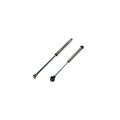What are Stainless Steel Gas Springs (Struts)?
There are two types of Stainless Steel Gas Springs:

Stainless Steel Standard Gas Springs

Stainless Steel Reducible Force Gas Springs
Custom Solutions
If your OEM or aftermarket application requires something not available in the catalog of stainless-steel standard parts, ASRaymond’s team of engineers can help design, manufacture, and stock a custom solution. See the engineering page for additional information.
Fitting Gas Springs
Gas Springs and Dampers have seals where the rod meets the body. The springs must be installed in the proper orientation for the seal to last to its optimal lifecycle. For whichever position is most often occurring in the application, the rod end of the spring should be installed lower than the body. Installing the spring in this manner helps keep oil on the seal for lubrication purposes. For example, if a hood spends most of the time closed, the rod must be lower than the body in the closed position.